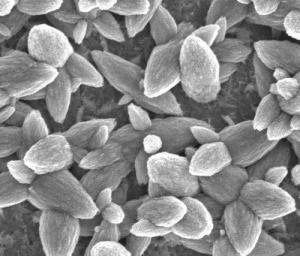Aug 23 2010
Researchers at Oregon State University and the Pacific Northwest National Laboratory have discovered a new way to apply nanostructure coatings to make heat transfer far more efficient, with important potential applications to high tech devices as well as the conventional heating and cooling industry.
These coatings can remove heat four times faster than the same materials before they are coated, using inexpensive materials and application procedures.
The discovery has the potential to revolutionize cooling technology, experts say.
The findings have just been announced in the International Journal of Heat and Mass Transfer, and a patent application has been filed.
 This nanoscale-level coating of zinc oxide on top of a copper plate holds the potential to dramatically increase heat transfer characteristics and lead to a revolution in heating and cooling technology, according to experts at Oregon State University and the Pacific Northwest National Laboratory.
This nanoscale-level coating of zinc oxide on top of a copper plate holds the potential to dramatically increase heat transfer characteristics and lead to a revolution in heating and cooling technology, according to experts at Oregon State University and the Pacific Northwest National Laboratory.
"For the configurations we investigated, this approach achieves heat transfer approaching theoretical maximums," said Terry Hendricks, the project leader from the Pacific Northwest National Laboratory. "This is quite significant."
The improvement in heat transfer achieved by modifying surfaces at the nanoscale has possible applications in both micro- and macro-scale industrial systems, researchers said. The coatings produced a "heat transfer coefficient" 10 times higher than uncoated surfaces.
Heat exchange has been a significant issue in many mechanical devices since the Industrial Revolution.
The radiator and circulating water in an automobile engine exist to address this problem. Heat exchangers are what make modern air conditioners or refrigerators function, and inadequate cooling is a limiting factor for many advanced technology applications, ranging from laptop computers to advanced radar systems.
"Many electronic devices need to remove a lot of heat quickly, and that's always been difficult to do," said Chih-hung Chang, an associate professor in the School of Chemical, Biological and Environmental Engineering at Oregon State University. "This combination of a nanostructure on top of a microstructure has the potential for heat transfer that's much more efficient than anything we've had before."
There's enough inefficiency in heat transfer, for instance, that for water to reach its boiling point of 100 degrees centigrade, the temperature of adjacent plates often has to be about 140 degrees centigrade. But with this new approach, through both their temperature and a nanostructure that literally encourages bubble development, water will boil when similar plates are only about 120 degrees centigrade.
To do this, heat transfer surfaces are coated with a nanostructured application of zinc oxide, which in this usage develops a multi-textured surface that looks almost like flowers, and has extra shapes and capillary forces that encourage bubble formation and rapid, efficient replenishment of active boiling sites.
In these experiments, water was used, but other liquids with different or even better cooling characteristics could be used as well, the researchers said. The coating of zinc oxide on aluminum and copper substrates is inexpensive and could affordably be applied to large areas.
Because of that, this technology has the potential not only to address cooling problems in advanced electronics, the scientists said, but also could be used in more conventional heating, cooling and air conditioning applications. It could eventually find its way into everything from a short-pulse laser to a home air conditioner or more efficient heat pump systems. Military electronic applications that use large amounts of power are also likely, researchers said.
The research has been supported by the Army Research Laboratory. Further studies are being continued to develop broader commercial applications, researchers said.
"These results suggest the possibility of many types of selectively engineered, nanostructured patterns to enhance boiling behavior using low cost solution chemistries and processes," the scientists wrote in their study. "As solution processes, these microreactor-assisted, nanomaterial deposition approaches are less expensive than carbon nanotube approaches, and more importantly, processing temperatures are low."